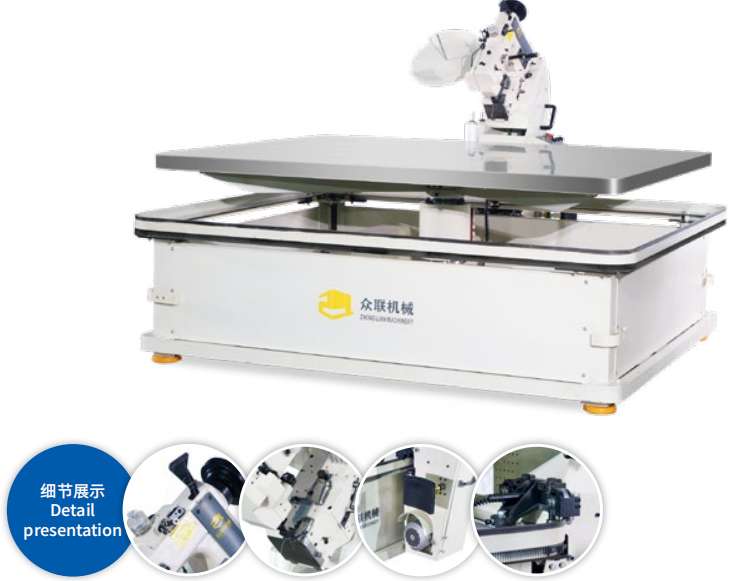
Rising labor costs, inconsistent quality, and inefficient workflows are limiting many mattress factories from growing and scaling to meet global demand.
By upgrading machinery, training staff, and optimizing workflows, mattress manufacturers can significantly improve production efficiency, reduce costs, and enhance product quality.
These improvements are especially crucial for factories targeting export markets, where speed, consistency, and flexibility determine long-term competitiveness.
What role does automation play in mattress machinery efficiency?

Manual operations take time, increase the risk of errors, and limit production output.
Automation—through robotic arms, automated conveyors, and PLC-controlled machines—helps reduce cycle times, improve consistency, and minimize labor costs.
Key Benefits of Automation:
- Cutting and sewing precision: Robots can handle repetitive tasks with high accuracy.
- PLCs (Programmable Logic Controllers): These systems enable machines to auto-adjust, monitor faults, and optimize parameters in real time.
- Automated conveyors: Reduce material transfer time and minimize bottlenecks between workstations.
Automation frees up human workers to manage quality control or machine supervision, increasing overall plant productivity.
Why is regular maintenance so important?
Machines break down more often when maintenance is reactive instead of proactive.
Regular inspections, lubrication, and calibration prevent unexpected failures and keep mattress machines running smoothly.
Maintenance Efficiency Tips:
| Task | Frequency | Goal |
|---|---|---|
| Lubrication | Weekly | Reduce part friction |
| Electrical check | Monthly | Prevent power faults |
| Calibration | Quarterly | Maintain accuracy |
When manufacturers combine regular maintenance with targeted upgrades like servo motors or intelligent sensors, even older machines can deliver better performance.
How can workflow layout improve production speed?
Bad layouts cause delays, unnecessary worker movement, and material handling inefficiencies.
Optimizing the floor plan according to lean manufacturing principles helps reduce waste, shorten lead times, and boost output.
Common Workflow Optimizations:
- U-shaped layouts for seamless flow between cutting, sewing, and packing.
- Dedicated buffer zones to prevent jams during high-volume orders.
- Visual signals (kanban cards, color-coded bins) for faster material management.
When each machine is placed strategically and every movement has a purpose, the factory becomes much more efficient.
How does operator training influence efficiency?
Even the most advanced equipment is useless if operators don’t know how to run or maintain it properly.
Continuous employee training improves machine operation, reduces errors, and builds a culture of improvement.
Training Should Include:
- Machine operation
- Emergency shutdown and safety
- Troubleshooting and quick fixes
- Preventive maintenance routines
Well-trained teams also adapt faster to new technology upgrades, minimizing transition delays during machinery upgrades.
Can data analytics help optimize production?
Many factories don’t know which machine slows them down or where most defects occur.
With smart sensors and factory dashboards, production data can be collected, analyzed, and turned into actionable insights.
Metrics to Monitor:
| Metric | Benefit |
|---|---|
| Cycle time | Identify slow machines |
| Defect rate | Improve quality control |
| Machine uptime | Optimize maintenance schedules |
Data lets factory managers pinpoint bottlenecks, balance workloads, and make confident decisions to improve overall output.
Why does quality control impact production speed?
Defects create rework, which adds time, labor, and cost to every mattress produced.
Implementing automated quality checks reduces defects early in the process, ensuring only passable units reach packaging.
Quality Systems That Improve Efficiency:
- Vision sensors: Scan for defects in spring alignment or stitching.
- SPC tools (Statistical Process Control): Detect subtle deviations in real time.
- Inline rejection units: Automatically remove defective units without stopping the line.
By minimizing rework and returns, factories keep production steady and reduce wasted materials.
Do better raw materials improve efficiency?
Low-quality springs or fabrics can slow down machines, cause jams, and lead to higher defect rates.
High-quality and consistent raw materials reduce the likelihood of equipment issues, boosting speed and output.
Reliable suppliers also mean:
- Fewer delivery delays
- Fewer specification mismatches
- Less need for incoming quality checks
Paying slightly more for better input often means saving more downstream.
Is energy usage linked to production efficiency?
Old machines waste energy when idle, during startup, or through inefficient motors.
Modern equipment uses energy-efficient drives, programmable shut-offs, and smart sensors to reduce power consumption.
Energy Efficiency Features:
- Inverter motors: Adjust speed based on load
- Auto sleep mode: Powers down during inactivity
- Real-time monitoring: Tracks energy used per batch
Energy savings directly reduce your cost-per-unit, making operations more profitable.
What role does continuous improvement play?
Factories that improve efficiency once often plateau. Those that improve constantly win long-term.
By adopting lean principles, setting KPIs, and empowering workers to suggest changes, factories unlock ongoing efficiency gains.
Daily huddles, suggestion boards, and regular KPI reviews encourage small changes that add up—such as:
- Shorter glue warm-up cycles
- Faster bag feeding techniques
- Better spring stacking tools
It’s not one big idea. It’s 100 small improvements that push your output further.
Conclusion
Improving the production efficiency of mattress machinery isn’t about one machine or one method — it’s a full system approach. With smart layouts, better-trained staff, real-time data, and proactive maintenance, any factory can produce more, waste less, and stay ahead of competitors.
